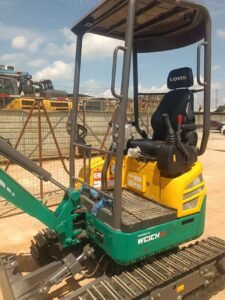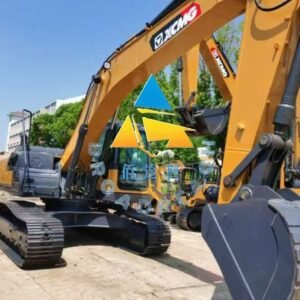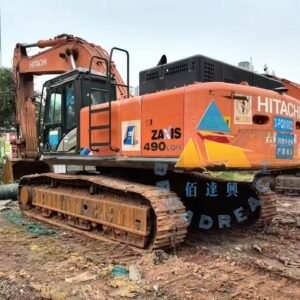BroadReach Construction Machinery Co., Ltd

What used excavator buckets can be used for after purchase
When you invest in a used excavator, the bucket is more than just an attachment—it’s a workhorse that can adapt to a myriad of tasks across industries. Whether you’ve acquired a pre-owned excavator for construction, agriculture, or landscaping, the bucket itself holds untapped potential beyond its original design. From demolishing concrete to sorting recyclables, used excavator buckets can be repurposed, modified, or deployed in creative ways to maximize efficiency and cut costs. This article explores the diverse applications of used excavator buckets after purchase, shedding light on how these seemingly simple attachments can become the backbone of the most demanding projects.
Construction and Demolition: The Core Functions Reimagined
In the construction sector, a used excavator bucket is often the first tool contractors reach for—and for good reason. These attachments are built to handle heavy-duty tasks, and even a pre-owned bucket can tackle rigorous jobs with the right maintenance.
Demolition and Material Removal
A used excavator with a standard demolition bucket can tear down walls, concrete structures, or old foundations with ease. The bucket’s teeth, though possibly worn, still provide the leverage needed to break apart tough materials. For example, a contractor renovating an old warehouse might use a second-hand rock bucket—originally designed for quarry work—to smash through reinforced concrete floors. The key is to assess the bucket’s condition: check for cracks in the welds, worn teeth, or structural damage, as even a used bucket can perform reliably if it’s been well-maintained.
Grading and Site Preparation
Pre-owned excavator buckets are ideal for grading projects, where precision matters more than brute force. A used grading bucket, with its flat bottom and smooth edges, can level soil, create drainage slopes, or prepare foundations for new construction. Landscapers often repurpose these buckets to shape gardens, driveways, or golf course fairways, taking advantage of the bucket’s durability at a fraction of the cost of a new attachment. For instance, a landscaping company might buy a used excavator with a worn-down general-purpose bucket, then modify it by welding on additional plates to extend its lifespan for light grading tasks.
Foundation Digging and Trenching
Trenching buckets, often found on used excavators, are designed for narrow, deep excavations—perfect for laying pipes, cables, or foundations. Even if the bucket’s cutting edge is slightly dulled, it can still dig trenches efficiently in non-rocky soil. A utility company, for example, might purchase a used excavator with a trenching bucket to install water mains in a suburban area, saving money on equipment while meeting project deadlines. Regular sharpening of the bucket’s edge can extend its usability, making a pre-owned attachment just as effective as a new one for routine trenching work.
Agriculture and Land Management: From Fields to Forests
The agricultural sector thrives on versatility, and used excavator buckets offer farmers and land managers a cost-effective solution for a range of tasks.
Soil Preparation and Crop Planting
A used excavator with a general-purpose bucket can till soil, remove rocks, or create furrows for planting. While specialized agricultural equipment exists, a pre-owned excavator bucket can serve multiple functions on a budget. For example, a small-scale farmer might use a second-hand excavator bucket to break up compacted soil in a new field, then switch to a narrower attachment to dig rows for planting crops. The bucket’s capacity to move large volumes of soil quickly makes it invaluable during planting seasons, especially when time is of the essence.
Irrigation and Drainage Projects
Installing irrigation systems or improving drainage requires digging trenches for pipes or creating channels for water flow. A used trenching bucket can handle these tasks efficiently, even in clay or loamy soils. Ranchers, for instance, might use a pre-owned excavator bucket to dig ditches that redirect rainwater away from livestock areas, preventing mud and waterlogging. The key is to ensure the bucket’s width matches the project’s needs—some used buckets can be adjusted or modified with add-on extensions to fit specific trench dimensions.
Forestry and Land Clearing
In forestry and land management, used excavator buckets with specialized features like root rakes or thumb attachments become essential. A root rake bucket, often found on used machines, can clear brush, remove stumps, or sort logs during timber operations. For example, a logging company might purchase a used excavator with a root rake bucket to clear a site for new tree plantings, efficiently removing debris and small roots without damaging the surrounding soil. Thumb attachments, which grip and lift materials, can be added to used buckets to enhance their functionality for tasks like stacking logs or moving boulders.
Recycling and Waste Management: Sorting Through the Essentials
The recycling industry relies on heavy equipment to process and sort materials, and used excavator buckets offer a practical, cost-effective solution for these tasks.
Material Sorting and Handling
Used excavator buckets can be fitted with specialized teeth or grapples to sort recyclables like metal, concrete, or wood. For example, a recycling facility might use a pre-owned excavator with a sorting bucket—designed with widely spaced teeth—to separate scrap metal from concrete debris. The bucket’s durability is crucial here, as it often interacts with sharp or abrasive materials. Even if the bucket shows signs of wear, such as chipped teeth, it can still perform effectively for sorting tasks that don’t require extreme force.
Waste Compaction and Loading
In landfills or waste transfer stations, used excavator buckets are ideal for compacting waste and loading it onto trucks. A heavy-duty compaction bucket, often found on second-hand machines, can compress materials to maximize landfill space or prepare waste for transport. Waste management companies frequently opt for used buckets due to their lower cost, especially when the attachment is exposed to corrosive or hazardous materials that might shorten its lifespan. Regular maintenance, such as replacing worn cutting edges or reinforcing the bucket’s base, can extend its usability in these demanding environments.
Recycling Concrete and Asphalt
Used excavator buckets can be repurposed to break down and process recycled concrete or asphalt. A rock bucket with sturdy teeth, even if pre-owned, can crush old pavement into aggregate for new construction projects. For instance, a company specializing in green building might use a used excavator bucket to crush concrete debris from a demolition site, turning it into base material for new roads or foundations. This not only saves money on equipment but also reduces waste and promotes sustainability.
Creative Modifications: Transforming Used Buckets for Unique Needs
One of the most innovative aspects of used excavator buckets is their potential for modification. With a little creativity and welding skill, these attachments can be transformed to fit specialized tasks.
Custom Attachments for Niche Industries
Small businesses or niche industries often require unique tools that aren’t mass-produced. A used excavator bucket can serve as the base for a custom attachment. For example, a marine construction company might take a used dredging bucket and modify it with a mesh screen to sift sand from underwater debris. Similarly, a mining operation could reinforce a used bucket with abrasion-resistant steel plates to handle abrasive ore materials. These modifications are often cheaper than buying a new specialized attachment, making used buckets a cost-effective solution for unique projects.
Art and Sculpture Projects
In unexpected contexts, used excavator buckets have even found a place in art and public installations. Artists have repurposed worn-out buckets into sculptures, planters, or functional art pieces. For instance, a community art project might transform a used excavator bucket into a giant planter for a public square, painting it in vibrant colors and drilling drainage holes. While this isn’t a traditional industrial use, it highlights the bucket’s versatility and the creative possibilities that come with repurposing heavy equipment parts.
DIY Solutions for Small Businesses
Small contractors or homeowners often face budget constraints, and used excavator buckets can be adapted for DIY projects. A landscaping company, for example, might weld a flat plate to the bottom of a used bucket to create a makeshift road grader for maintaining private driveways. Alternatively, a homeowner with a small farm could attach a bucket to a used excavator and add hooks for lifting hay bales, eliminating the need for a dedicated loader. These DIY modifications require basic welding skills but can save thousands of dollars compared to buying specialized equipment.
Maintenance and Longevity: Extending the Life of Your Used Bucket
To maximize the applications of a used excavator bucket, proper maintenance is key. Even a pre-owned bucket can last for years with the right care.
Routine Inspections and Repairs
Regularly inspect the bucket for cracks, worn teeth, or loose parts. Weld any small cracks immediately to prevent them from spreading, and replace broken teeth with compatible replacements. For example, if you notice a crack in the bucket’s lip after a demolition job, have it welded by a professional before using it again. This proactive approach can prevent costly breakdowns and extend the bucket’s lifespan.
Surface Protection and Coating
Apply a protective coating to the bucket’s surface to resist corrosion and abrasion. Used buckets that have been exposed to moisture or harsh materials may show signs of rust, which can weaken the metal over time. Sandblasting the bucket and applying a durable paint or epoxy coating can protect it from further damage. For instance, a bucket used in coastal areas, where saltwater can cause corrosion, should be coated regularly to maintain its structural integrity.
Matching the Bucket to the Task
Avoid overusing a used bucket for tasks it wasn’t designed for. While versatility is an advantage, using a general-purpose bucket for heavy rock excavation can accelerate wear. Instead, match the bucket’s type to the task: use a rock bucket for tough materials, a grading bucket for precision work, and a demolition bucket for tearing down structures. This not only preserves the bucket but also improves efficiency on the job.
Case Studies: Real-World Applications of Used Excavator Buckets
Looking at real-life examples highlights how businesses have leveraged used excavator buckets to drive success.
Case Study 1: Construction Company Saves Costs on Demolition
A mid-sized construction firm purchased a used excavator with a demolition bucket for a commercial renovation project. The bucket, though five years old, had well-documented maintenance records and showed minimal wear. By using the pre-owned bucket instead of renting a new one, the company saved 40% on equipment costs. The bucket performed flawlessly during the demolition phase, breaking up concrete walls and removing debris efficiently. After the project, the company repurposed the bucket for grading on a subsequent site, proving its multi-tasking value.
Case Study 2: Farmer Transforms Used Bucket for Irrigation
A family farmer in the Midwest bought a used excavator with a standard trenching bucket to install a new irrigation system. The bucket, which had been used in a previous construction job, was modified with a custom extension to increase its trench depth. The farmer spent a fraction of the cost on the used bucket compared to buying new, and the modification allowed them to dig trenches for water pipes quickly. The same bucket was later used for tilling soil and removing rocks from fields, demonstrating its versatility across agricultural tasks.
Case Study 3: Recycling Facility Optimizes with Used Equipment
A recycling center specializing in concrete and metal waste purchased a used excavator with a sorting bucket. The bucket, designed with spaced teeth, was perfect for separating metal scraps from concrete chunks. Although the bucket had some wear on its cutting edge, the facility refurbished it with new teeth and a protective coating. The used bucket enabled the center to process materials faster, increasing their daily throughput by 25% while keeping equipment costs low. The investment in the pre-owned attachment paid for itself within six months.
Overcoming Common Misconceptions About Used Buckets
Myth 1: “Used excavator buckets are too worn to be reliable.”
Reality: With proper inspection and maintenance, a used bucket can perform just as well as a new one. Many pre-owned buckets have been well-cared for by previous owners, and even those with minor wear can be refurbished at a low cost.
Myth 2: “Used buckets can only do one type of job.”
Reality: The versatility of used excavator buckets is a major advantage. From construction to agriculture to recycling, these attachments can be adapted to countless tasks, especially with creative modifications.
Myth 3: “Buying new is always better for long-term use.”
Reality: While new buckets come with warranties, used buckets offer a higher cost-to-value ratio, especially for businesses on a budget. With regular upkeep, a used bucket can provide years of reliable service without the steep initial investment.
Unleashing the Full Potential of Your Used Excavator Bucket
The purchase of a used excavator bucket is not just a transaction—it’s an opportunity to unlock a world of possibilities. From core construction tasks to innovative DIY projects, these attachments prove that durability, adaptability, and cost-effectiveness can coexist. Whether you’re a contractor, farmer, recycler, or creative mind, a used excavator bucket can be the workhorse that drives your projects forward—provided you understand its capabilities and invest in proper maintenance.
In the ever-evolving landscape of industry and innovation, the humble excavator bucket stands as a testament to the power of practicality. By seeing beyond its initial purpose and embracing its potential for repurposing, you transform a simple attachment into a versatile tool that pays dividends long after the purchase. So, the next time you acquire a used excavator or its bucket, remember: the only limit to its applications is your imagination. With the right approach, your pre-owned bucket will not only meet your current needs but also open doors to new opportunities you never thought possible.






